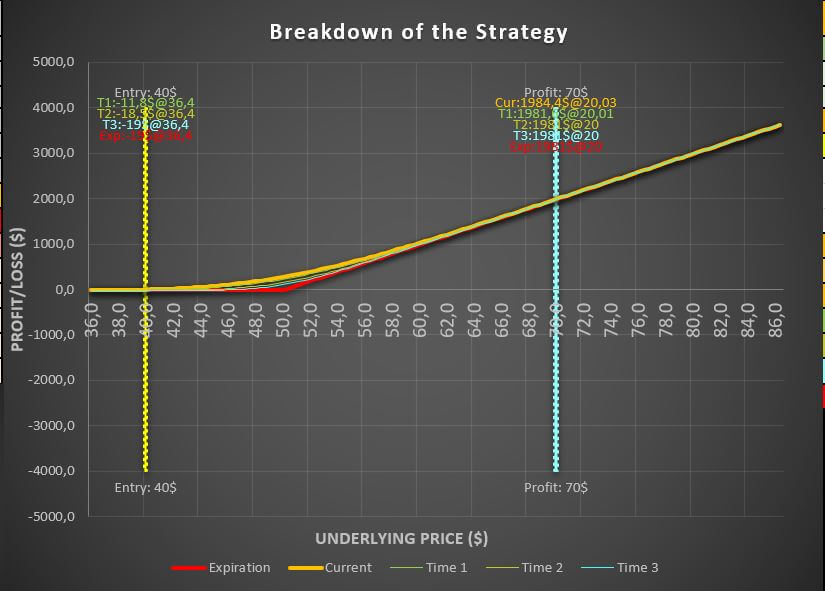Pros and Cons of Options Trading: What You Need to Know Before Investing
Options trading can be a complex and risky investment strategy that requires a higher level of knowledge and experience. However, it also provides strategic freedom and flexibility compared to traditional investments. In this article, we’ll explore the pros and cons of options trading, including the potential rewards and risks, so you can evaluate whether it is the right investment strategy for you.
What Are Options?
Options are financial contracts that provide the buyer and seller the right but not the obligation to buy or sell underlying financial assets at a fixed price, referred to as the “strike price,” before the option’s expiration date.
Definition of Options
An option is a contract that gives its holder the right, but not the obligation, to buy or sell the underlying security at a specified price, known as the strike price, within a specified time period. In return for the right, the holder usually pays a premium to the seller.
Call and Put Options
The two most common types of options are call options and put options. A call option gives the holder the right, but not the obligation, to buy the underlying asset at the strike price, while a put option gives the holder the right, but not the obligation, to sell the underlying asset at the strike price.
How Options Work
Options contracts consist of various terms, such as the strike price and expiration date. The holder of an option has the right to exercise it by the expiration date. If the holder exercises a call option, they buy the underlying asset at the strike price, while if the holder exercises a put option, they sell the underlying asset at the strike price. If the option is not exercised, it expires worthless.
- The holder of an options contract can sell the option to another investor in a secondary market.
- The seller of an options contract is obligated to fulfill the terms of the contract if the holder decides to exercise their right to buy or sell the underlying asset.
- The price of an option is influenced by factors such as the price of the underlying asset, the strike price, the expiration date, volatility, and interest rates.
Understanding the basics of options trading is crucial before investing, as it can be a complex and risky investment strategy.
The Advantages of Trading Options
Options trading can offer an array of benefits for investors. It allows for more flexibility and strategic freedom compared to traditional investments. In this section, we will delve into the advantages of trading options, including limited risk, strategic flexibility, and high return potential.
Limited Risk
The limited risk is an attractive feature for many investors. With options trading, you have the ability to set a maximum loss level, providing a degree of protection from unforeseen market fluctuations. Additionally, by only investing the amount you are willing to lose, you can avoid significant financial losses.
Strategic Flexibility
Options trading provides more strategic flexibility than other investment strategies. You can use options to protect against unexpected market swings, increase income, and even speculate on market movements. With call options, you can obtain a right to buy stock at a fixed price, while put options give you the right to sell stock at a fixed price, allowing you to tailor your investment strategy to your needs.
High Return Potential
While options trading can be complex and risky, it offers high return potential for investors. Investors can purchase options at lower prices than the underlying asset, providing the potential for a significant return on investment. Additionally, options trading provides the opportunity to earn profits in any market condition, even in a down market.
In conclusion, options trading provides considerable advantages for investors, including limited risk, strategic flexibility, and high return potential. However, it is important to note that options trading is complex and requires a higher level of knowledge and experience. New investors should take the time to gain some knowledge and experience before diving into options trading and should understand their investment goals and strategy before making any trades.
The Risks of Trading Options
Although options trading can offer potentially high returns, it is crucial to understand the potential risks involved before trading. In this section, we will explore the main risks associated with options trading.
Unlimited Loss Potential
One of the main risks of options trading is that it carries the potential for unlimited losses. When buying options, you have limited risk, as you can only lose the purchase price of the option. However, if you sell options, you may face an unlimited loss potential, as the stock price can increase or decrease significantly before the option’s expiration date. Therefore, traders must be aware of the unlimited risk potential before engaging in options trading.
Additional Costs and Fees
Another factor to consider when trading options is the additional costs and fees that come with it. Options trading can be more expensive than traditional trading due to several factors, such as margin requirements, commissions, and other transaction fees. Additionally, some brokers may charge higher fees for providing options trading services. Therefore, traders must be aware of the extra costs and fees associated with options trading when considering this investment strategy.
Complexity and Technical Language
Options trading can be a complex investment strategy that demands a higher level of knowledge and experience than traditional trading. It involves technical language, regulations, margin requirements, and other complex factors that a trader must understand before engaging in options trading. Therefore, traders must be prepared to invest time and effort in learning about options trading and its technical language, particularly when engaging in advanced strategies.
Options Trading Strategies
Options trading strategies are techniques used by investors to maximize return potential while limiting risk. There are several strategies available, each with their own unique advantages and risks.
Covered Calls
A covered call is an options trading strategy that involves both purchasing shares of stock and selling call options on those same shares. This strategy is used to increase portfolio income and provide additional protection against potential losses. The investor expects the stock price to remain relatively stable and receives premium income from selling the call option. However, if the stock price increases significantly, the investor risks losing out on potential profits from the sale.
Protective Puts
A protective put is an options trading strategy that involves purchasing a put option on a stock that an investor already owns. This strategy is used to protect against potential losses if the price of the stock drops. The investor pays a premium for the put option, and if the stock price decreases, the put option will increase in value and offset the losses from the stock holding. However, if the stock price does not drop, the put option will expire worthless, and the investor will have lost the premium payment.
Married Put Strategy
The married put strategy is a hybrid of the covered call and protective put options trading strategies. It involves both owning shares of stock and purchasing a protective put option on those shares. The put option acts as insurance, protecting against potential stock losses, while the stock can still be sold at any time for potential profit. The downside of this strategy is the cost of purchasing both the stock and the put option, which can be more expensive than other strategies.
Trading Options: A Short-Term Investment Strategy
Options trading can be an appealing choice for short-term investors who want to take advantage of short-term price movements in the market. This section explores some of the benefits and risks of trading options for short-term investment purposes, including:
Short-Term Price Movements
- The ability to profit from small price movements in a stock
- The potential for high returns in a short period of time
- The ability to leverage a smaller amount of money into a larger position
Short-term trading in options allows investors to capitalize on changes in the market quickly. Unlike traditional long-term investments, short-term options trading is designed to benefit from small price movements that occur within a limited period. Using options for short-term investment can offer great leverage and low investment costs, making it a suitable strategy for active traders.
Risks and Rewards of Short-Term Trading
- The potential for high returns also means that there is high risk involved
- Options can expire worthless, resulting in significant losses
- Short-term trading requires confidence and discipline, as well as a good understanding of market trends and technical analysis
Despite the potential for high returns, short-term options trading can be risky. For example, since options expire at a set date, if the security price doesn’t move in the direction predicted by the trader, the option may expire worthless, causing the investor to lose their entire initial investment. Additionally, successfully trading options on a short-term basis requires a deep understanding of the markets and a willingness to take risks, so it may not be suitable for all investors.
Overall, short-term options trading can be an effective investment strategy for those willing to take on the risks involved. It helps investors to take advantage of small price movements in the market and make high returns in a short period of time. However, it also requires skill, experience, and discipline, as well as a good understanding of market trends and technical analysis.
Trading Options for Long-Term Investment
Options trading can be a great tool for long-term investment, offering investors the opportunity to diversify their stock portfolio and protect against market risks. Here are two strategies for trading options for long-term investment:
Using Options to Diversify a Stock Portfolio
One way investors can use options for long-term investment is by diversifying their stock portfolio. Options can provide exposure to other asset classes, such as commodities or foreign currencies, without having to invest directly in them. These options can be used to reduce the overall risk of an investor’s portfolio. For example, if an investor holds a large number of tech stocks, they may use options to invest in other industries or areas, such as healthcare or utilities.
Investors can also use options to hedge against potential losses in their stock holdings. For instance, if an investor holds a large number of shares in a particular company, they may buy put options on those shares as a hedge against a potential price decline. If the stock’s price does decline, the put options would increase in value, offsetting some of the losses in the investor’s stock holdings.
Options as a Hedge Against Market Risk
Options can also be a useful hedging tool for investors concerned about market risks. The purchase of put options can provide protection against market downturns, while the purchase of call options can provide exposure to market upswings. For example, an investor who is concerned about a potential downturn in the market might buy put options on the S&P 500 index to hedge against potential losses in their portfolio. Similarly, an investor who is bullish on the market might buy call options on the S&P 500 index to gain exposure to potential gains.
Keep in mind that options trading for long-term investment can still involve risks, and it is important for investors to have a clear understanding of their investment goals and strategy before investing.
Choosing the Right Options Trading Strategy for You
Options trading offers investors a range of strategies to balance risk and reward, and choosing the right one for you depends on your investment goals and risk tolerance.
Evaluating your Investment Goals
Before embarking on any investment strategy, you should consider your investment goals. Are you looking to make quick profits or secure long-term growth? Are you investing for retirement or for a major purchase in the future?
Options trading can be a useful tool for many investment strategies, but its complexity requires traders to focus on short-term goals and make adjustments on an ongoing basis. You may seek to generate income, hedge against market risk, or benefit from specific trends in the market. Whatever your goals, be sure to have them clearly defined before choosing an options trading strategy.
Balancing Risk and Reward
Choosing the right options trading strategy depends on your ability to balance risk and reward. Some strategies offer high rewards with a limited downside, while others involve greater risk in exchange for the potential for large returns. Trading options is not for the faint of heart, and you should be aware of the potential for significant losses.
Iron condors, covered calls, and protective puts are just a few of the many options trading strategies that allow investors to balance the risk and reward of their portfolios. Understanding each strategy and its associated risks is crucial to building a balanced portfolio that meets your investment goals.
Investment Advice and Resources
Options trading is complex and requires a higher level of knowledge and experience. You should seek investment advice from a professional before investing in options and take advantage of the many resources available, such as books, podcasts, and online trading courses, to help you understand the intricacies of options trading.
There are many online trading platforms, such as RMoney Market Place, that offer a range of advisory plans, algo trading, FPI services, authorized person (AP) services, and options for online trading, mutual funds, back-office, and fund transfer. Be sure to choose a reputable platform with a strong track record of success and positive reviews from other investors.
Ultimately, the key to choosing the right options trading strategy is to understand your investment goals, balance risk and reward, and seek professional advice to help you navigate the complexities of the market.
- Consider your investment goals before choosing an options trading strategy.
- Balance risk and reward to build a successful portfolio.
- Seek investment advice from a professional and take advantage of available resources.
Bottom Line: Is Options Trading Right for You?
Now that you have evaluated the potential advantages and risks of options trading and have learned about the different strategies available, you need to determine whether this investment strategy matches your risk tolerance and investment goals.
Assessing Your Risk Tolerance
Before investing in options, it is important to assess your risk tolerance. Options trading involves the possibility of significant losses, and you must be prepared to accept the risks involved. If you are risk-averse, you may feel more comfortable investing in less risky options, and if you are more willing to take risks, you may appreciate the high return potential of trading options.
Considerations Before Investing
Before starting to trade options, it’s important to consider a few things:
- Make sure to fully understand what options trading is, how it works, and its potential advantages and risks.
- Set a budget for your options trading activities and stick to it.
- Do your research: learn about the market and the companies included in the options you plan to trade, and track their performance over time.
- Have a plan: set clear investment goals and develop a strategy for achieving them, making sure to factor in the potential risks involved.
Making Your First Options Trade
If you have assessed your risk tolerance and are ready to invest in options, your first options trade can be both exciting and intimidating. Here are a few tips to help you make your first trade:
- Start with small investments to minimize risk.
- Use a practice trading account to learn how to trade options before investing real money.
- Choose a reputable broker, who can offer investment advice, education, and research resources.
- Make sure to place a limit order to purchase options at a fixed price, which can help minimize your risks.
It is important to remember that options trading is complex and risky. Before investing, it is crucial to have a solid understanding of this investment strategy and to evaluate whether it is the right investment choice for you. By assessing your risk tolerance, considering key factors before investing, and making your first options trade with care, you can make informed choices that could lead to increased returns and a successful options trading experience.





